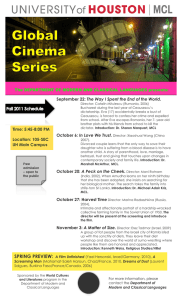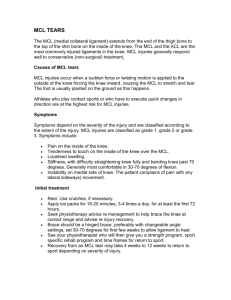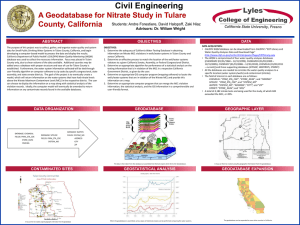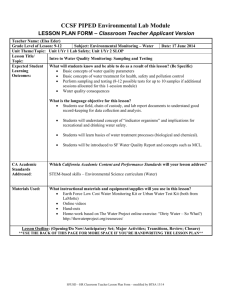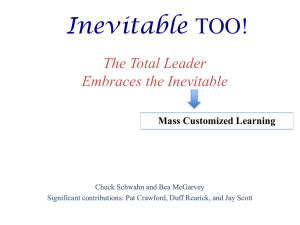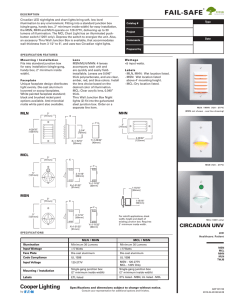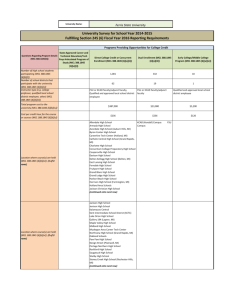Tool: Summary of New Roles Created by Opportunity Culture Models
advertisement
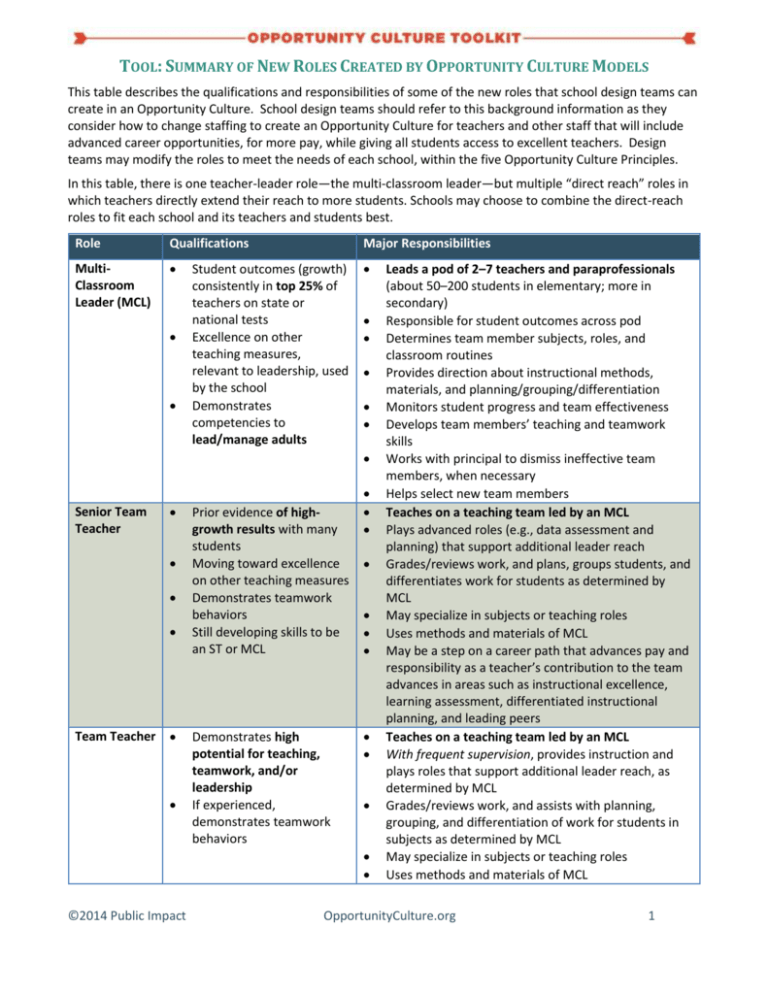
TOOL: SUMMARY OF NEW ROLES CREATED BY OPPORTUNITY CULTURE MODELS This table describes the qualifications and responsibilities of some of the new roles that school design teams can create in an Opportunity Culture. School design teams should refer to this background information as they consider how to change staffing to create an Opportunity Culture for teachers and other staff that will include advanced career opportunities, for more pay, while giving all students access to excellent teachers. Design teams may modify the roles to meet the needs of each school, within the five Opportunity Culture Principles. In this table, there is one teacher-leader role—the multi-classroom leader—but multiple “direct reach” roles in which teachers directly extend their reach to more students. Schools may choose to combine the direct-reach roles to fit each school and its teachers and students best. Role Qualifications Major Responsibilities MultiClassroom Leader (MCL) Student outcomes (growth) consistently in top 25% of teachers on state or national tests Excellence on other teaching measures, relevant to leadership, used by the school Demonstrates competencies to lead/manage adults Senior Team Teacher Team Teacher Prior evidence of highgrowth results with many students Moving toward excellence on other teaching measures Demonstrates teamwork behaviors Still developing skills to be an ST or MCL Demonstrates high potential for teaching, teamwork, and/or leadership If experienced, demonstrates teamwork behaviors ©2014 Public Impact Leads a pod of 2–7 teachers and paraprofessionals (about 50–200 students in elementary; more in secondary) Responsible for student outcomes across pod Determines team member subjects, roles, and classroom routines Provides direction about instructional methods, materials, and planning/grouping/differentiation Monitors student progress and team effectiveness Develops team members’ teaching and teamwork skills Works with principal to dismiss ineffective team members, when necessary Helps select new team members Teaches on a teaching team led by an MCL Plays advanced roles (e.g., data assessment and planning) that support additional leader reach Grades/reviews work, and plans, groups students, and differentiates work for students as determined by MCL May specialize in subjects or teaching roles Uses methods and materials of MCL May be a step on a career path that advances pay and responsibility as a teacher’s contribution to the team advances in areas such as instructional excellence, learning assessment, differentiated instructional planning, and leading peers Teaches on a teaching team led by an MCL With frequent supervision, provides instruction and plays roles that support additional leader reach, as determined by MCL Grades/reviews work, and assists with planning, grouping, and differentiation of work for students in subjects as determined by MCL May specialize in subjects or teaching roles Uses methods and materials of MCL OpportunityCulture.org 1 Role Qualifications Major Responsibilities Specialized Teacher (ST) BlendedLearning Teacher (BLT) Remote BlendedLearning Teacher Learning Coach (LC) Digital Lab Monitor (LM) ©2014 Public Impact Student outcomes (growth) consistently in top 25% of teachers on state or national tests Excellence on other teaching measures Student outcomes (growth) consistently in top 25% of teachers on state or national tests Excellence on other teaching measures Student outcomes (growth) consistently in top 25% of teachers on state or national tests Excellence on other teaching measures Previous experience working with children Demonstrates strong interpersonal and development behaviors Teamwork behaviors At least two years of college Knowledge of subject matter being taught Previous experience working with children Strong computer skills, including troubleshooting software and hardware issues Bachelor’s degree a plus, but not required May be first step on a career path that advances pay and responsibility with increased team contribution Teaches a larger-than-typical load of students in a specialized teaching role, or, in elementary school, teaches just one or two subjects, with the help of other staff who handle other subjects and noninstructional tasks Spends most of day teaching or planning Teaches a larger-than-typical load of students, focusing on higher-order skills, because students rotate through a digital learning lab, for ageappropriate time periods, where they receive basic content instruction Spends most of day teaching or planning Teaches a larger-than-typical load of students from a remote location, focusing on higher-order skills, because students rotate through a digital learning lab, for age-appropriate time periods, where they receive basic content instruction Engages and motivates students remotely Partners with Learning Coaches, who are on-site with students Manages students during less structured times and transitions Identifies and addresses individual students’ social, emotional, and behavioral needs, and develops their organizational and time-management skills Maintains administrative duties for teachers Helps with tutoring in areas of content knowledge, under direction and using tools/rubrics of teacher(s) May partner with on-site or remotely located teacher(s) Ensures that students are working productively in the digital learning lab Trains and re-trains to ensure all students can use equipment and software Assists with software and hardware issues Answers basic questions about learning content, when possible Ensures that teacher(s) receive student data generated from software for planning instruction OpportunityCulture.org 2 Role Qualifications Major Responsibilities Tutor (T) Previous experience working with children Knowledge of subject matter being taught Bachelor’s degree a plus, but not required Previous experience working with children Bachelor’s degree a plus, but not required Instructional Assistant Variation: Knowledge of subject matter being taught Assistant Teacher ©2014 Public Impact Implements small-group and individual interventions determined by teacher(s) that personalize and tailor instruction Assesses student learning progress in the intervention group and communicates to teacher(s) using provided tools/rubrics May review student work using rubrics from teacher(s), and provides frequent feedback to students Manage student behavior during transitions and less structured time (e.g., recess, lunch) Monitor independent work time in classroom while teacher provides instruction Hold students accountable for high expectations of behavior and engagement that are ambitious and measurable Maintain administrative duties on behalf of teacher OpportunityCulture.org 3 COMPARING THE CORE MODELS Elementary Specialization MultiClassroom Leadership TimeTechnology Swap (blended learning) Class-Size Changes 100%–300% 100%–700% 25%–100% 10%–40% REQUIRES… … some teachers to lead other teachers … some elementary teachers to specialize in 1–2 core subjects … some class sizes to be larger … students to receive part of their instruction digitally … teachers or students to rotate REACH POTENTIAL (percentage of additional students reached by excellent teachers) Note: Remote teaching models may have any of these characteristics, aligned with role designs in table. COMPARING TEACHING ROLES Teaching Role Works Under Another Teacher’s Direction Leads Other Teachers Multi-Classroom Leader (MCL) - Specialized Teacher (ST) - - Blended Learning Teacher (BLT) - - Team Teacher (TT) Reach Extended - Delivers Classroom Instruction - Note: Remote teaching models may have any of these characteristics, aligned with role designs in table. ©2014 Public Impact OpportunityCulture.org 4
